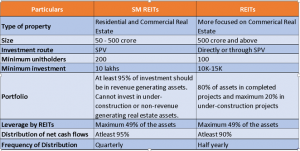Real estate has long been considered a cornerstone for wealth creation and portfolio diversification. However, for many retail investors, access to this lucrative asset class has been limited by high entry barriers, lack of transparency, and regulatory complexities. Recognizing this gap, the Securities and Exchange Board of India (SEBI) has taken a significant stride by introducing new regulations tailored for Small and Medium Real Estate Investment Trusts (SM REITs).
The recent notification from SEBI regarding SM REITs particularly targets retail investors and aims to democratize access to high quality income generating real estate projects. In this blog, we delve into SEBI’s regulatory framework for SM REITs.
What are REITs?
A Real Estate Investment Trust (REIT) is a company that owns, operates, or finances income-producing Real Estate properties which may comprise apartment buildings, offices, malls, warehouses, etc. Most REITs focus on a particular property type, but some hold multiple types of properties in their portfolios. The aim is to generate rental income from these properties and pass it on to unit holders. REITs are beneficial for retail investors as they let one participate in high-quality real estate properties with minimal investment and no maintenance and earn regular income from them.
Read more about REITs here.
What is the new regulation regarding SM REITs?
The Securities and Exchange Board of India (SEBI), has recently introduced new regulations aimed at facilitating investment in high-quality residential projects through the fractional investment route, particularly targeting retail investors. These regulations specifically cater to Small and Medium Real Estate Investment Trusts (SM REITs), which are designed to pool funds from investors under specified schemes.
The move is intended to provide investors with an opportunity to participate in large real estate projects with smaller investment amounts, while also ensuring regulatory oversight to protect their interests, given that fractional real estate investment is currently largely unregulated.
The definition of SM REITs, as per the regulatory framework, pertains to real estate investment trusts that pool money from investors under one or more schemes and satisfy the following criteria
- The size of assets that the SM REIT aims to acquire must fall within the range of at least 50 crores and less than 500 crores.
- The scheme of the SM REIT must have a minimum of 200 unitholders, excluding the investment manager, its related parties, and associates.
Moreover, there are eligibility criteria for the investment manager of SM REITs, which include:
- A net worth of at least 20 crores, with at least 10 crores in the form of liquid assets.
- A minimum of two years of experience in the real estate industry or real estate fund management.
Additionally, there are provisions regarding the “skin in the game”, mandating that the company holds a minimum stake of 5% in the units for the initial five years and 15% of the units if there is debt involved. These units must be unencumbered and locked in for a specified period.
Furthermore, lending restrictions are imposed, prohibiting the scheme of SM REIT from lending to entities other than its own Special Purpose Vehicle (SPV). SPV is also restricted from lending to any other entity.
In terms of distribution, the investment manager is obligated to ensure that at least 95% of the net distributable cash flows of the SPV are distributed to the scheme of SM REIT, with 100% of this amount ultimately distributed to the unitholders. Quarterly distribution declarations are mandatory and payment to unitholders is to be made within 7 days from the distribution announcement.
Overall, these regulations aim to foster a conducive environment for retail investors to participate in real estate investments through SM REITs, offering transparency, regulatory oversight, and investor protection within the framework of fractional real estate investment.
Comparison between REITs and SM REITs

Final Words
SM REITs offer retail investors an opportunity to diversify their portfolios with income-generating real estate assets. With SEBI’s regulatory framework in place, we will likely see lots of SM REITs listed in the exchanges soon. SM REITs stand as a promising avenue for wealth creation and portfolio diversification and are likely a huge step towards democratizing real estate investments.
~Nischay Avichal
















